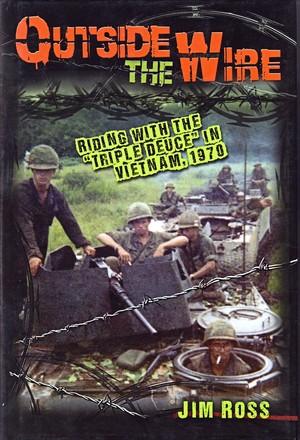 This book is different. It’s different from what I typically read and it’s different from what Jim Ross typically writes. It is also different from other Vietnam memoirs; at least I think it is. I’ve not read a ton of Vietnam memoirs so I can’t speak to that last point with any authority but I can try to explain why I believe it. In the more than forty years between the events told of in the book and the book’s completion, Ross wrote or co-wrote several other books and developed some formidable writing skills. That’s hardly all he learned, of course, but he somehow manages to keep most of those other things out of this book. In Outside the Wire: Riding with the “Triple Deuce in Vietnam, 1970, Jim Ross tells the story of a twenty year old kid, including the words and thoughts of that kid, with the skill of an accomplished writer and my sense is that that is a rare combination.
This book is different. It’s different from what I typically read and it’s different from what Jim Ross typically writes. It is also different from other Vietnam memoirs; at least I think it is. I’ve not read a ton of Vietnam memoirs so I can’t speak to that last point with any authority but I can try to explain why I believe it. In the more than forty years between the events told of in the book and the book’s completion, Ross wrote or co-wrote several other books and developed some formidable writing skills. That’s hardly all he learned, of course, but he somehow manages to keep most of those other things out of this book. In Outside the Wire: Riding with the “Triple Deuce in Vietnam, 1970, Jim Ross tells the story of a twenty year old kid, including the words and thoughts of that kid, with the skill of an accomplished writer and my sense is that that is a rare combination.
Not different is the basic story being told. Thousands of kids got drafted, trained, and sent off to Vietnam to shoot and be shot at. The details vary, of course. In Ross’ case, the shooting started with an M16 then he eventually became the man behind the 50 caliber machine gun mounted atop the armored personnel carrier to which he was assigned. Being shot at started with misdirected cluster bombs fired by US artillery then went on to include grenades, mortars, machine gun fire and other assorted projectiles from the other side. Even when the enemy wasn’t actively sending harmful things their way, the men had plenty to fear from the booby traps and land mines that were left behind.
I recall briefly questioning, early on in my read, how anyone could remember such detail through all those years but I soon realized that these are the sort of details that it is impossible to forget. Ross did some truly heroic things in Vietnam and he tells about them quite matter-of-factly. He also did some rather dumb things and tells about them just as matter-of-factly. That is not to say that the book is only a catalog of facts. Ross is as adept at describing his younger self’s emotions — plenty of fear and anger — as he is at describing the actions of a firefight.
Both friend and foe figure into that fear and anger. Being afraid of and angry at someone who is trying to kill you is pretty easy to understand but the soldiers on the ground also feared that the higher-ups would do something stupid and were justifiably angry when they did. From a four decade distance, it might be tempting to write about anger being directed at the safe-at-home politicians responsible for the war’s existence but that was rarely the case. For the most part, an enlisted grunt was concerned only with the decisions that affected his odds of staying alive for the next hour or day. Blame was rarely directed higher than the platoon leader. It only happened when it seemed that some big shot was padding his resume at their expense. After a particularly costly battle in tight quarters, Ross comments that:
Once again they had proven that mechanized infantry was always good for a sucker punch when shackled by terrain. It was as if we had brought a gun to a knife fight and still lost. Even though they had likely sustained greater loses, the psychological edge was theirs.
Several pages of color photographs help illustrate Ross’ words. These are not the artful photographs Ross fans are used to seeing in books like Route 66 Sightings. These are snapshots of soldiers taken by other soldiers. They no doubt help in visualizing what the words describe but the words need little help. The words paint vivid pictures. They are profane. They are the words soldiers use in profane situations and there is no more profane situation than war.
Ross draws no conclusion and does no preaching. What he does do is bring veteran skills to the telling of a rookie’s story. Well done.
Outside the Wire: Riding with the “Triple Deuce in Vietnam, 1970, Jim Ross, Stackpole Books, February 2013, 9.1 x 6.1 inches, 320 pages, ISBN 978-0811712224
Available through Amazon.

 This book could be called a near opposite of the one in my most recent review. That one contained lots of information and was well researched but not so well written. The Narrow Road: An Adventure on the Lincoln Highway tells me little that’s new and involved almost no research but is fairly well written. Yes, I do have variety in my reading.
This book could be called a near opposite of the one in my most recent review. That one contained lots of information and was well researched but not so well written. The Narrow Road: An Adventure on the Lincoln Highway tells me little that’s new and involved almost no research but is fairly well written. Yes, I do have variety in my reading.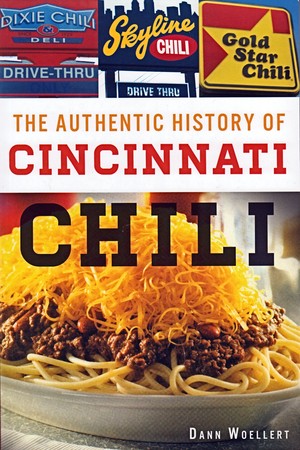 There is definitely a lot of information in this book. That’s why it’s here. I’ve often said that all my reviews are positive not because I like everything I read but because I see no reason to spend time reviewing something I don’t like. The Authentic History of Cincinnati Chili had me wavering. The subject matter is clearly in my strike zone. History? Check. Cincinnati? Check. Chili? Are you kidding? This looks like a book that could have been written specifically for me, right? Digging into it, however, was not quite as tasty as I thought it would be.
There is definitely a lot of information in this book. That’s why it’s here. I’ve often said that all my reviews are positive not because I like everything I read but because I see no reason to spend time reviewing something I don’t like. The Authentic History of Cincinnati Chili had me wavering. The subject matter is clearly in my strike zone. History? Check. Cincinnati? Check. Chili? Are you kidding? This looks like a book that could have been written specifically for me, right? Digging into it, however, was not quite as tasty as I thought it would be.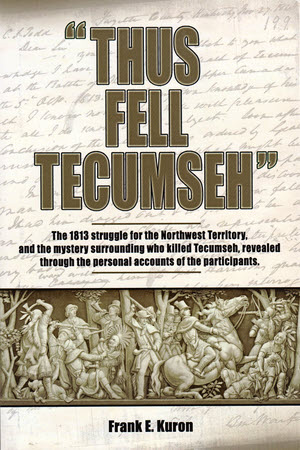 One of the few undisputed facts of Tecumseh’s life is the date of his death. The date of his birth is only known approximately and there are multiple possibilities for its location. He was born about March 1768 somewhere in the Ohio territory. It’s pretty much accepted that he met his end at the Battle of the Thames but that statement isn’t quite as precise as it might appear. While it is generally believed, as most reports indicate, that he died as a combatant in the battle, reports do exist that describe his death as an accidental shooting some distance away from the actual fighting. What no one questions is that Tecumseh was alive on the morning of October 5, 1813, and dead at the end of the day.
One of the few undisputed facts of Tecumseh’s life is the date of his death. The date of his birth is only known approximately and there are multiple possibilities for its location. He was born about March 1768 somewhere in the Ohio territory. It’s pretty much accepted that he met his end at the Battle of the Thames but that statement isn’t quite as precise as it might appear. While it is generally believed, as most reports indicate, that he died as a combatant in the battle, reports do exist that describe his death as an accidental shooting some distance away from the actual fighting. What no one questions is that Tecumseh was alive on the morning of October 5, 1813, and dead at the end of the day.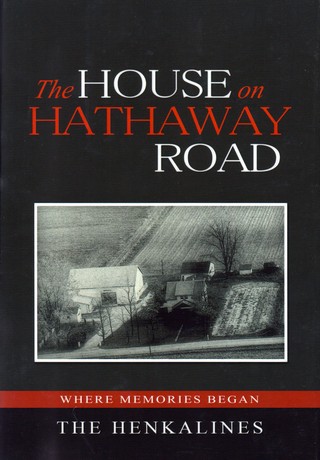 Not only did I graduate from high school smack dab in in the middle of the ’60s, it was smack dab in the middle of the Henkalines, too. There were four of them; a girl and three boys. The girl was a few years older than the boys. The oldest boy graduated a year before me and the next a year after. Though I was most familiar with the two boys closest to me in age, I knew them all. It was a small school in a small town in rural Ohio. Everybody knew everybody.
Not only did I graduate from high school smack dab in in the middle of the ’60s, it was smack dab in the middle of the Henkalines, too. There were four of them; a girl and three boys. The girl was a few years older than the boys. The oldest boy graduated a year before me and the next a year after. Though I was most familiar with the two boys closest to me in age, I knew them all. It was a small school in a small town in rural Ohio. Everybody knew everybody.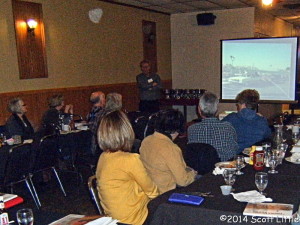
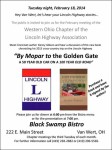
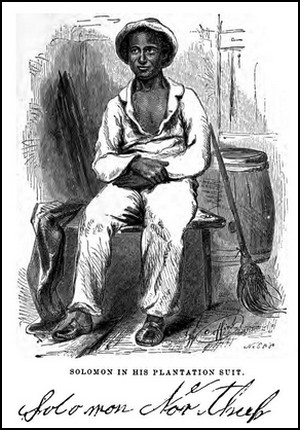 Like most of the world, I had no idea this book even existed before the movie about the New Yorker kidnapped into slavery came out. When I saw the movie, I was moderately less impressed than some but I left the theater with two basic questions: was the book an actual memoir and how close did the movie track it? As I poked around the internet, I encountered no suspicion that either Solomon Northup or the story he told were fiction which made the answer to the first question “yes”. I then located a free PDF copy of the book and set out to answer the second question myself. I had my doubts as I read the book’s early pages but it became apparent before too long that that answer was “very close”.
Like most of the world, I had no idea this book even existed before the movie about the New Yorker kidnapped into slavery came out. When I saw the movie, I was moderately less impressed than some but I left the theater with two basic questions: was the book an actual memoir and how close did the movie track it? As I poked around the internet, I encountered no suspicion that either Solomon Northup or the story he told were fiction which made the answer to the first question “yes”. I then located a free PDF copy of the book and set out to answer the second question myself. I had my doubts as I read the book’s early pages but it became apparent before too long that that answer was “very close”. I thought of reviewing this ebook when it came out last March but it didn’t happen. There were actually multiple items, including a couple of CDs, that were review candidates about that time which got pushed aside by stuff like preparations for the coming summer. By releasing this second edition, Terri Weeks combines a reminder that I missed posting a review last year along with a second chance.
I thought of reviewing this ebook when it came out last March but it didn’t happen. There were actually multiple items, including a couple of CDs, that were review candidates about that time which got pushed aside by stuff like preparations for the coming summer. By releasing this second edition, Terri Weeks combines a reminder that I missed posting a review last year along with a second chance.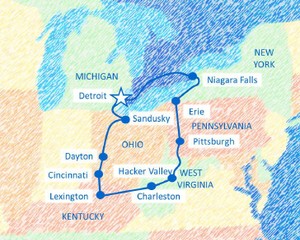 The book is not large, 40 pages, 4.5 KB. There are no detailed directions. There is a general map, like the one at left, for each trip followed by a daily itinerary. Itinerary entries are usually one-liners with any details provided through a web link. Being an ebook, How to Visit All 50 States in 12 Trips can assume some connectivity that paper books can’t. That means web links for many attractions. Sometimes the links lead directly to an attraction’s website and sometimes, for attractions already visited, to a Travel 50 States with Kids blog entry which often contains a link to the attraction’s website along with a report on the family’s visit.
The book is not large, 40 pages, 4.5 KB. There are no detailed directions. There is a general map, like the one at left, for each trip followed by a daily itinerary. Itinerary entries are usually one-liners with any details provided through a web link. Being an ebook, How to Visit All 50 States in 12 Trips can assume some connectivity that paper books can’t. That means web links for many attractions. Sometimes the links lead directly to an attraction’s website and sometimes, for attractions already visited, to a Travel 50 States with Kids blog entry which often contains a link to the attraction’s website along with a report on the family’s visit.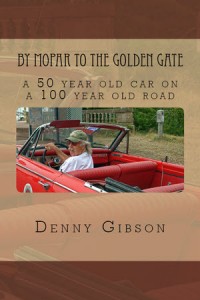 By coincidence, the first review of my own book, By Mopar to the Golden Gate, appeared yesterday. Written by Ron Warnick at Route 66 News, the very positive in depth review can be read
By coincidence, the first review of my own book, By Mopar to the Golden Gate, appeared yesterday. Written by Ron Warnick at Route 66 News, the very positive in depth review can be read 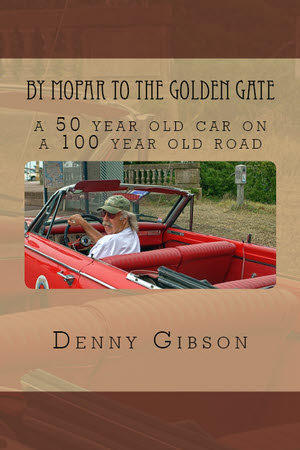
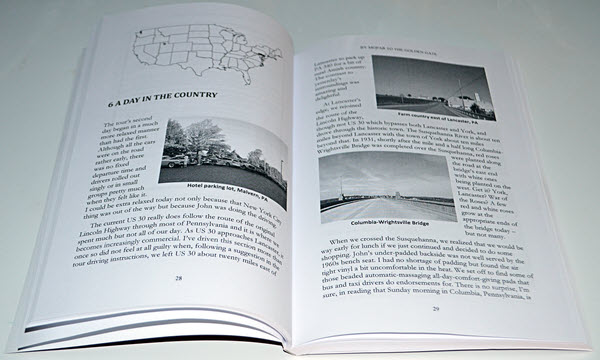
 Everyone loves a winner and, in 1794, the United States Army finally became one. In his earlier work,
Everyone loves a winner and, in 1794, the United States Army finally became one. In his earlier work,